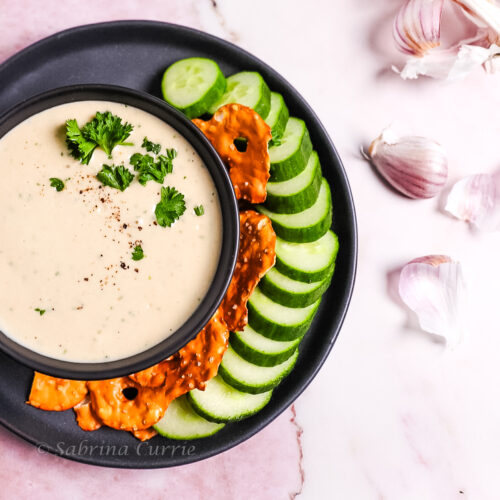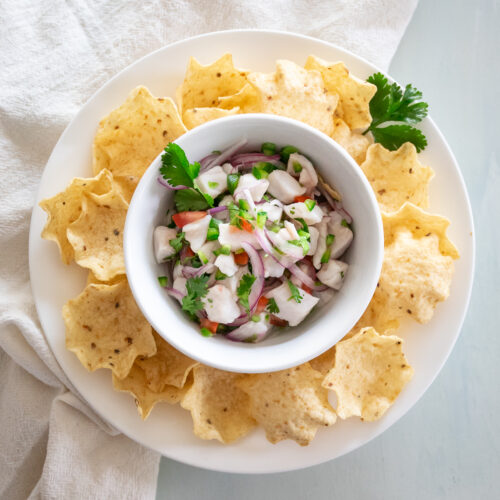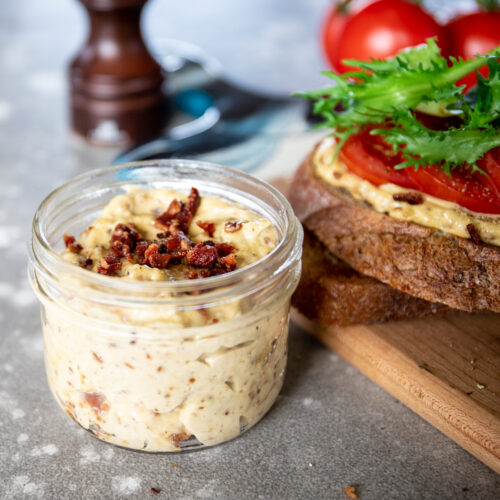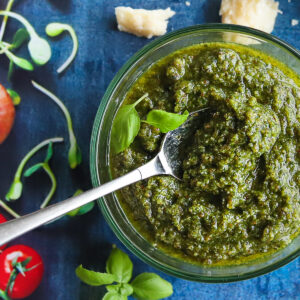Easy lemon dill aioli with garlic is fresh and light tasting. It's quick and easy to make and is a fantastic spread, dip and sauce for French fries, salmon, shrimp, chicken, potatoes, veggies, sandwiches and more. This homemade dill mayo is FULL of flavor, done in under 10 minutes and here's how to make it! (GF, DF)

Why I Love This Recipe
Dill aioli is such a versatile sauce and only takes minutes to make. In the summer it's fantastic on tomato sandwiches or in potato salad. In the winter, I love it on bruschetta topped with smoked salmon or in grilled chicken sandwiches.
It's an all round great sauce to use as a veggie dip or on green salads in place of ranch dressing. It's extra tasty as a sandwich spread or burger condiment instead of mayonnaise, and a delicious creamy base for grilled fish and chicken. Try it with these salmon patties or crab fritters!
Jump to:
Aioli is a classic French sauce and popular in the Mediterranean region. For more delicious sauce and dip recipes, try my Basil Aioli, Mutabal Eggplant Dip, Caramelized Onion and Blue Cheese Dip or Peanut Dipping Sauce.
Ingredients
This recipe is made with super simple ingredients. It's like a fun science experiment! Watch the frothy yellow egg yolks turn into a creamy, pale green spread as the yolk molecules absorb the oil and other flavors. Basic ingredients turn into good quality mayo right before your eyes!

- Egg yolks - The yolks are the key ingredient that will emulsify with the oil and make this sauce thicken. Just the yolks are needed for the aioli to achieve a thick and creamy consistency, you can save the egg white for meringues or omelets.
- Lemon juice: This tangy ingredient provides the perfect acidity to balance out the richness of the egg yolks and olive oil. For extra lemon flavor without too much acidity, this recipe calls for the lemon zest too.
- Fresh dill: The fresh flavor of dill complements the lemon and adds a subtle herbaceous note to the aioli. Fresh dill is preferable but if you only have dried dill, use 2-3 teaspoons in place of the fresh.
- Garlic cloves: Use one (or two) fresh garlic cloves, depending on your preference for the intensity of garlic flavor. Fresh garlic gives a much better and more pure flavor than dried garlic. In a pinch, you can use (a ½ teaspoon) dried garlic instead.
- Oil - Neutral, light vegetable oil like canola or sunflower oil is best for this light and delicate tasting aioli recipe. If you love the flavor of extra virgin olive oil, use half olive oil and have vegetable oil. Using all olive oil will overwhelm the delicate flavors of the lemon and dill.
See recipe card for quantities.
Top Tip:
Bring your ingredients to room temperature before starting. This will ensure that they emulsify easily. Take your eggs and lemon juice out of the fridge about an hour before making the aioli for best results.
Substitutions + Variations
Don't want to risk raw eggs? Have lots of herbs but not dill? Here are some easy substitutions and variations for this garlic dill aioli recipe.
- Raw Eggs - If you're uncomfortable using raw eggs in your aioli, you can pasteurize them by placing them in a bowl over a pot of simmering water until they reach 140°F. Alternatively, you can use a pasteurized egg product or a commercial mayonnaise base in place of the egg and oil.
- Dill + Other Fresh Herbs - Dill is great but you can switch it up with almost any other fresh, soft green herbs. Thyme, chives, tarragon and cilantro all make great flavored aioli recipes. While you can use smaller amounts of dried herbs in this recipes, fresh herbs will produce the best flavor.
(Check out my favorite bacon aioli or basil anchovy aioli here.)
Step-by-Step Instructions
Making lemon dill aioli is a simple process and the same as making traditional aioli. I use a food processor but if you want to use a whisk or immersion blender instead, see the FAQ's below for detailed instructions.
Note: Whichever method you choose, make sure your ingredients are at room temperature before starting. This will help the aioli emulsify easily.

Step 1. In a medium sized bowl or the bowl of a food processor, add egg yolks, lemon juice and minced garlic. Whisk or process until whipped and creamy looking.

Step 2. Add in a few drips of oil and whisk or process until incorporated. Repeat this step 2 more times. After some oil has been emulsified in, you can add the oil slightly faster (a teaspoon at a time), whisking or blending well after each addition. (If you have an opening in the lid of your processor, slowly drizzle in the extra-virgin olive oil with the motor running until the aioli has emulsified and thickened up.) Be sure to add the oil in a slow, steady stream to prevent the aioli from breaking.

Step 3. Add dill, lemon zest, hot sauce, salt and pepper to the bowl and process again until it is all well incorporated.

Step 4. Taste and season to taste with extra salt, pepper or hot sauce as desired.
If your aioli is too thick, you can thin it out by adding a little bit of warm water, a teaspoon at a time, until you reach your desired consistency.
Troubleshooting Common Problems with Aioli
Although making traditional French aioli is simple, it can also be frustrating when things go wrong. Here are some common problems and how to fix them.
- Broken Aioli - If the emulsion breaks and the aioli separates, don't worry. To fix it, whisk another egg yolk in a separate bowl and then very slowly whisk in the broken aioli until it combines again.
- Too Thick - If your aioli is too thick, whisk in a tiny bit of water or lemon juice until it reaches a thinner consistency.
- Too Thin - If your aioli is too thin, whisk in another egg yolk or more oil until it thickens up. This shouldn't be a problem if the recipe is followed exactly.
Storage
This recipe will store well for 1 week in the fridge. Keep it covered in an airtight container. Aioli does not freeze well.
Because homemade aioli uses raw egg yolk, it is particularly perishable if left out. If you decide to take it for a picnic (a great idea by the way), place it on an ice pack in your bag or basket to keep it cool while you're out.
FAQ
While fresh dill is recommended for the best flavor, you can substitute dried dill if you don't have fresh on hand. Use 2-3 teaspoons of dry dill weed in place of the fresh.
Yes. Start by whisking together the egg yolks, lemon juice, garlic, and fresh dill until everything is well combined. Slowly drizzle in the extra-virgin olive oil while whisking continuously until the aioli has emulsified and thickened up.
Tip: For a shortcut, you can substitute the whisk for a handheld electric mixer or a stand mixer fitted with the whisk attachment.
If you're using an immersion blender, blend the egg yolks, lemon juice, garlic, and fresh dill together in a tall, narrow container. Slowly drizzle in the extra-virgin olive oil with the motor running until the aioli has emulsified and thickened up. Move the immersion blender up and down to ensure all the ingredients are well blended.
Homemade lemon dill aioli can typically be stored in an airtight container in the refrigerator for up to one week. However, it is best consumed within a few days for optimal freshness,
Yes, you can use a different type of oil. Because oil is a main ingredient in aioli, choose a neutral flavored oil such as avocado oil or grapeseed oil. Keep in mind that it may slightly alter the flavor of the aioli so choose an oil that you like the flavor of and isn't too strong tasting.
If you prefer a spicier aioli, you can add a pinch of cayenne pepper or a few extra dashes of hot sauce to the mixture. Adjust the amount to your taste preferences.
Lemon dill aioli pairs well with a variety of dishes. Crab cakes, salmon cakes, salmon burgers, fish sticks, tuna cakes, and grilled chicken breasts. French fries, crudités, green salad and more. It can also be used as a delicious spread on sandwiches and burgers. I particularly love this aioli with grilled asparagus and salmon.
Top tip
Don't add the oil to the lemon dill aioli sauce too fast at the beginning. Using a small squeeze bottle works great to add just a few drops at a time, or spoon the oil into the bowl slowly with a teaspoon, whisking well between each addition.

Easy lemon dill aioli with garlic is mouth-wateringly good with crispy crab cakes, salmon cakes and fish sticks. It's also fantastic as a dipping sauce for golden brown French fries or tuna cakes, a spread on a fresh salmon burger or juicy grilled chicken breasts. Aioli is the perfect condiment to make if you have some fresh herbs on hand. Have I convinced you yet?
Pin It To Save For Later
Pin this yummy lemon dill aioli recipe or share to Facebook to save it for next time!

More Dips + Sauces
For more new recipes, try some of my other favorite dips, sauces and condiments.
- Easy Creamy Cannellini Bean Hummus (White Bean Dip)
- Easy And Healthy Cod Ceviche With Lime and Jalapeño
- Hedgehog Cheeseball With Almonds (GF)
- Easy Homemade Bacon Aioli Sauce (Bacon Mayonnaise)
If you have any questions or comments, you can find me on Instagram, Pinterest and Facebook. I try to answer any recipe related questions quickly as I know you might be in the middle of making it.
Also check out my FREE PRINTABLE meal planner to make menu planning and grocery shopping a breeze and my shopping guide. And if you like this recipe, I would love it if you give it a star rating in the recipe card.
Cheers and happy cooking, Friends! Sabrina
📖 Recipe

Easy Lemon Dill Aioli With Garlic + How To Make It
Ingredients
- 2 Egg Yolks
- 1 clove Garlic, Minced
- 1 c Vegetable Oil
- ½ c Fresh Dill or 1.5 tablespoon dried dill
- 1 teaspoon Lemon Zest
- 1 tablespoon Lemon Juice
- ¼ teaspoon Tobasco (or other hot sauce)
- 1 teaspoon Sea Salt
- ¼ teaspoon Black Pepper
- Warm Water 1-2 tablespoon as needed
Instructions
- In a medium-sized bowl or the bowl of a food processor, add egg yolks, minced garlic, and lemon juice. Whisk or process until whipped and creamy-looking.
- Add in a few drips of olive oil and whisk or process until incorporated. Repeat this step 2 more times. After some oil has been emulsified in, you can add the oil slightly faster (a teaspoon at a time), whisking or blending well after each addition.
- Once about ⅓ of the oil has been incorporated, add in dill, lemon zest, hot sauce, salt and pepper. Keep adding the oil in small amounts and blending between each addition. Once the olive oil is used, add water and continue with the vegetable oil until it's all added and the aioli is thick.
- If you find the aioli too thick, you can add 1 teaspoon of water at a time until it's as loose as you like. Season to taste with additional salt and pepper if desired and serve or refrigerate.










Comments
No Comments